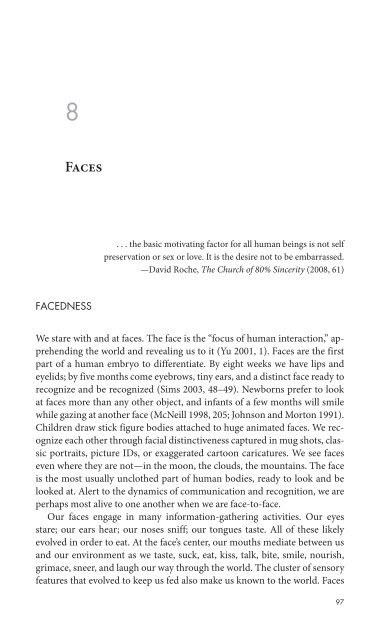Staring how we look sobre la mirada.pdf - artecolonial
Staring how we look sobre la mirada.pdf - artecolonial
Staring how we look sobre la mirada.pdf - artecolonial
You also want an ePaper? Increase the reach of your titles
YUMPU automatically turns print PDFs into web optimized ePapers that Google loves.
44 WHAT IS STARING?<br />
the advantage over me” (473). Whereas Fanon sees this dynamic as forming<br />
racial identity, here Sartre offers a triangu<strong>la</strong>tion complicating a simple formu<strong>la</strong><br />
of visual domination and subjection. Sartre is stared at while himself<br />
staring. The risk, then, in visually objectifying another is being caught doing<br />
it. Such fascinated <strong>look</strong>ing is simultaneous domination and subjection. The<br />
lesson of this parable is that the excessive, indecorous enthrallment of staring<br />
subjugates the starer by begetting shame.<br />
Sartre’s keyhole metaphor is a limited model of staring <strong>how</strong>ever. His keyhole<br />
captures the furtive and unseemly nature of a stare. This vantage point,<br />
like Foucault’s Panopticon, provides a “cone of vision” that opens out from<br />
the eye of a vie<strong>we</strong>r (Melville 1996, 104). But staring without the restriction<br />
of a keyhole reverses the shape of this visual cone. In fact, staring in modern<br />
urban life is most often a form of involuntary telescoping in which our roving,<br />
casual visual scanning focuses in on an unexpected sight.<br />
Understanding the kind of staring that enacts dominance is useful for illuminating<br />
inequities in po<strong>we</strong>r re<strong>la</strong>tions. The limitation, <strong>how</strong>ever, of focusing<br />
on this narrow but currently popu<strong>la</strong>r interpretation of visual social re<strong>la</strong>tions<br />
is that it can foreclose on the complexities of <strong>how</strong> <strong>we</strong> <strong>look</strong> at one another.<br />
Sartre goes a way in questioning the idea of the crushing force of a starer’s<br />
eye by s<strong>how</strong>ing his keyhole peeper to be simultaneously a starer and staree.<br />
Nonetheless, Sartre’s model of staring shuts down rather than opens up the<br />
encounter. Sartre’s starer/staree is “known” by his starer, but that knowledge<br />
results in an “advantage over” that is ultimately a domination that threatens<br />
the staree. The knowledge that the staring other gets from the encounter<br />
crushes the staree with shame for his own eager but furtive <strong>look</strong>ing.<br />
STARING AS STIGMA ASSIGNMENT<br />
Domination staring gives a starer po<strong>we</strong>r over a staree. <strong>Staring</strong> can also be a social<br />
act that stigmatizes by designating people whose bodies or behaviors cannot<br />
be readily absorbed into the visual status quo. Stigmatizing, according to<br />
sociologist Erving Goffman (1986), is social discrediting of those <strong>we</strong> perceive<br />
as different, as lesser than <strong>we</strong> are. Stigmatizing pushes others away rather than<br />
dominating them. Stigma, Goffman suggests, is not in the bodies of people<br />
considered disreputable but in social re<strong>la</strong>tions that deem some superior and<br />
others inferior. In other words, social interactions—such as staring—assign<br />
stigma to certain perceived traits. Goffman describes a hierarchy of stigma<br />
designations that begins with disability—or what he rather harshly terms<br />
“abominations of the body” (1986, 4). Next are character aspersions such<br />
as dishonesty, <strong>we</strong>ak will, or unnatural passions, which people associate with


